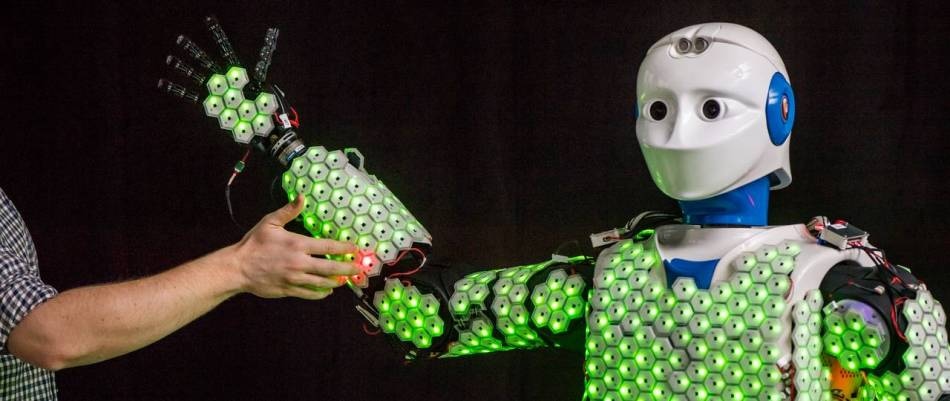Oct 11 2019
Sensitive artificial skin helps robots to feel their own bodies and environments. This is a key ability when they are in close contact with individuals.
 Thanks to the synthetic skin developed by Prof. Gordon Cheng and his team, robot H-1 is able to feel the touch of a human. New control algorithms made it possible for the first time to apply artificial skin to a human-sized robot. (Image credit: Astrid Eckert/TUM)
Thanks to the synthetic skin developed by Prof. Gordon Cheng and his team, robot H-1 is able to feel the touch of a human. New control algorithms made it possible for the first time to apply artificial skin to a human-sized robot. (Image credit: Astrid Eckert/TUM)
Based on human skin, researchers from the Technical University of Munich (TUM) have designed a system that integrates artificial skin with control algorithms. They used this to produce the first independent humanoid robot with full-body artificial skin.
The artificial skin created by Prof. Gordon Cheng and his team has hexagonal cells with a size close to that of a two-euro coin (which is around one inch in diameter). Each cell is provided with a microprocessor and sensors to detect contact, proximity, acceleration, and temperature.
Artificial skin such as this could help robots to sense their surroundings fully and accurately. Moreover, it can help robots to move safely and make them safer when working near people. It also provides them the potential to predict and actively prevent accidents.
Although Gordon Cheng, Professor of Cognitive Systems at TUM, developed the skin cells about a decade ago, this invention only exhibited its complete potential when combined with an advanced system as explained in the latest issue of Proceedings of the IEEE.
More Computing Capacity Through Event-Based Approach
Computing capacity has hindered the making of robot skin. Human skin contains about 5 million receptors. There are limitations while attempting to execute continuous data processing from sensors in artificial skin. Earlier systems were rapidly overloaded with data from almost a few hundred sensors.
To overcome these limitations, Gordon Cheng and his team used an event-based system to monitor the skin cells continuously instead of a neuroengineering approach. This minimizes the processing work by up to 90%. The crucial technique here is that the individual cells transfer data from their sensors only if values are changed, which is just like the way the human nervous system functions.
For instance, there is a feel when a hat is first placed; later, the person soon gets accustomed to the sensation. It is not required to observe the hat again till the wind blows it off one’s head. This allows the nervous system to focus on new feelings that need a physical response.
Safety Even in Case of Close Bodily Contact
Using the event-based approach, Prof. Cheng and his team have currently demonstrated the successful application of artificial skin to a human-sized standalone robot, which is independent of any external computation.
The H-1 robot contains 1260 cells (and over 13,000 sensors) on its upper body, legs, arms, and even the soles of its feet. This provides it with a new “bodily sensation.” For instance, H-1 uses its sensitive feet to respond to rough floor surfaces and even balance on single leg.
H-1’s unique skin enables it to even safely hug a person. It is less insignificant than it sounds as robots are capable of applying forces that can actually injure a human being. Two bodies touch in several different places while giving a hug. The robot should use this complicated information to evaluate the correct movements and apply the correct contact pressures.
This might not be as important in industrial applications, but in areas such as nursing care, robots must be designed for very close contact with people.
Gordon Cheng, Professor of Cognitive Systems, Technical University of Munich
Versatile and Robust
The robot skin system developed by Gordon Cheng is also highly versatile and strong. Since the skin has cells, and not a single piece of material, it works even when some cells cease working.
Our system is designed to work trouble-free and quickly with all kinds of robots. Now we’re working to create smaller skin cells with the potential to be produced in larger numbers.
Gordon Cheng, Professor of Cognitive Systems, Technical University of Munich
Sensitive Skin for Robots
(Video credit: TUM)